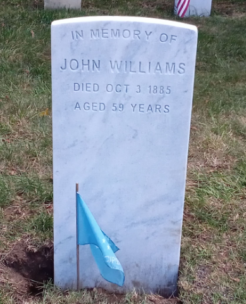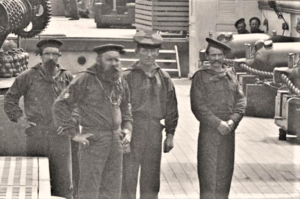Title: Navy Captain of the maintop, Civil War Medal of Honor
Birthdate: 1828
Death Date: October 3, 1885
Plot Location: Naval 1, Row 4, Grave 14, Yeadon, PA. GPS: 39.93654* N, 075.23911* W

Although he was born in New Orleans in 1828, John began his career in the Union Navy after a difficult start in life. The family apparently moved to New York City and found themselves on the Almshouse ledgers. John was just 12 years old but apparently not alone, since this was not an orphanage. The term refers to housing for the destitute but also included workhouses, prisons, hospitals, and asylums, and they were all together on what is now Roosevelt Island on the East River.
The likelihood of successfully navigating adolescence in this environment was poor, so, at age 20, John was convicted of larceny and served three years at Eastern State Penitentiary near Philadelphia. His prison record says his parents were dead and his trade was “boatman (Mexican volunteer).” He was sentenced September 27, 1848, which was eight months after the Mexican War. Perhaps this was where he got his first taste of life at sea.
It appears he changed direction and lived an honorable life after that. He next appears in a December, 1851 list of “Citizenship Affidavits of US-born Seamen” for the district and port of New York, and a similar list in 1859 in Philadelphia. Exactly when he joined the Navy is unknown, but the battle for which he was awarded the Medal of Honor took place just weeks after war had been declared.
John was on the USS Pawnee, a “sloop-of-war” laid down in the Philadelphia Navy Yard and launched in 1859.  Shown here is part of the crew and their cannons, although John may not be one of them. In 1861 he was in one of two row boats of sailors sent from the Pawnee to assist the USS Thomas Freeborn in attacking a Confederate base at Mathias Point on the Potomac River in Virginia.
Shown here is part of the crew and their cannons, although John may not be one of them. In 1861 he was in one of two row boats of sailors sent from the Pawnee to assist the USS Thomas Freeborn in attacking a Confederate base at Mathias Point on the Potomac River in Virginia.
They landed and attempted to build fortifications but were forced to retreat under heavy fire. In charge of one of the boats, John ordered his men to stay near shore until all members of the party were aboard. He was shot in the leg and the boat’s flagpole was hit, but he held up what was left of it until the boat reached the Thomas Freeborn. All members of the landing party were successfully evacuated.
His citation reads: “Served as captain of the maintop of the USS Pawnee in the attack upon Mathias Point (Virginia), 26 June 1861. Williams told his men, while lying off in the boat, that every man must die on his thwart sooner than leave a man behind. Although wounded by a musket ball in the thigh he retained the charge of his boat; and when the staff was shot away, held the stump in his hand, with the flag, until alongside the Freeborn.”
John was awarded the Medal of Honor nearly two years later on April 3, 1863 when he was aboard the USS Ticonderoga. His was the earliest action for which a Navy Medal of Honor was awarded, but he was not the first to receive the medal. Several other seamen who performed later actions were actually awarded the medal before him.
After the war John repeatedly re-enlisted and listed New York as his place of birth. In the mid-1870s he was assigned to the USRS Potomac (a “receiving ship” for new recruits) moored at the Philadelphia Naval Shipyard’s new location. It had just opened on what was once League Island, at the confluence of the Delaware and Schuylkill Rivers in South Philadelphia. He was admitted to the hospital there with pleurisy, a lung inflammation causing painful breathing.
After three weeks he returned to duty and then was stationed on the St Louis, another receiving ship in the Navy Yard, where he remained for the next nine years. He returned to the hospital for a month in early 1885 with chronic bronchitis, and again in August. It progressed to chronic pneumonia from which he died on October 3, 1885. His death certificate indicates he was married, but no other details have been found.

Support the Friends of Mount Moriah
Help us in our mission to restore and maintain the beautiful Mount Moriah Cemetery by donating to our cause or volunteering at one of our clean-up events.

